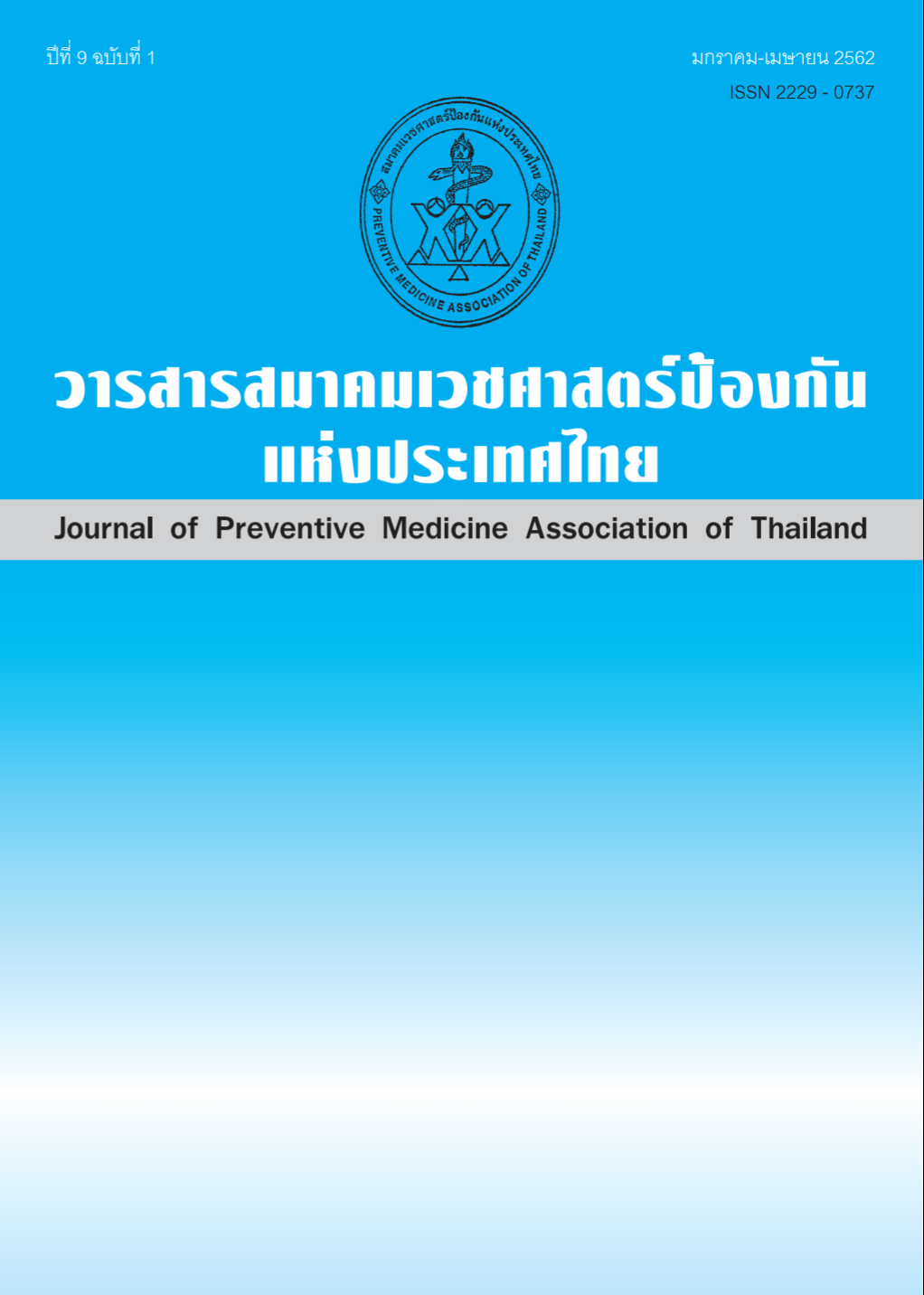Prevalence of Failure to Thrive in Children with the Age Below Two at Well Baby Clinic of Wat Phrayat Tikaram Health Promoting Hospital
Keywords:
failure to thrive, children with the age below two, prevalence, well baby clinicAbstract
Failure to thrive (FTT) in infants and toddlers can affect child health problems especially child development and immune function in long-term. Primary care services are first contact care for screening, initial management and referring. However, the studies of FTT in primary care services are inadequate in Thailand. Our goal in this study is to determine the prevalence of FTT and identify risk factors of failure to thrive in children with the age below two at well baby clinic of Wat Phrayat Tikaram Health Promoting Hospital. In this descriptive study, the growth data and general information of 151 children were collected during the age below two in well baby clinic of Wat Phrayat Tikaram Health Promoting Hospital from 2016 to 2018. And some data was collected from parents answer. Children were diagnosed FTT according to any of these diagnostic
criteria: 1) Weight for age (W/A) or Weight for height (W/H) below 3rd percentile on an appropriate growth chart 2) W/A or W/H decrease of two or more major percentile lines of growth chart. We found that the prevalence of FTT was 17.9% and possible factors, which related to FTT with statistically significant at the 0.05 level, included parental smoking (p=0.043), low birth weight (p=0.019), preterm labor (p< 0.001), and hospitalization (p=0.033). Based on the results of this study, the prevalence of FTT in children with the age below two at well baby clinic of Wat Phrayat Tikaram Promoting Hospital was quiet high. The factors which may be associated with FTT, included parental smoking, low birth weight, preterm labor, and hospitalization.
References
2. กลุ่มควบคุมป้องกันด้านโภชนาการ สำนักโภชนาการ กรมอนามัย. การประเมินภาวะโภชนาการเด็ก [อินเทอร์เน็ต]. [เข้าถึงเมื่อ 3 พฤษภาคม 2561]. เข้าถึงได้จาก: https://hpc4.anamai.moph.go.th/images/healthplaza/doc_kid/เอกสารหมายเลข%2022%20แนวทางการประเมินและรักษาภาวะโภชนาการเด็ก. pdf
3. Olsen EM, Petersen J, Skovgaard AM, Weile B, Jorgensen T, Wright CM. Failure to thrive: The prevalence and concurrence of anthropometric criteria in a general infant population. Arch Dis Child 2007;92:109-14.
4. Virginia K. Assessment of growth. In: Nelson Essentials of Pediatrics. 19th ed. Philadelphia: Elsevier Saunders; p.126-31.
5. Perrin E, Cole C, Frank D, Glicken S, Guerina N, Petit K, et al. Criteria for determining disability in infants and children: failure to thrive: summary. AHRQ [Internet] 2003.
[cited 2018 May 3]. Available from: https://www.ncbi.nlm.nih.gov/books/NBK11940/
6. Hegazi MA, Sehlo MG, Al-Jasir A, El-Deek BS. Development and cognitive functions in Saudi pre-school children with feeding problems without underlying medical disorders. J Paediatr Child Health 2015;51:906-12.
7. Kleinman RE, Greer FR. Failure to thrive. In: Pediatric nutrition.7th ed. American Academy of Pediatrics 2014; p.663-700.
8. Corbett SS, Drewett RF. To what extent is failure to thrive in infancy associated with poorer cognitive development? A review and meta-analysis. J Child Psychol Psychiatry 2004;45:641-54.
9. Homan GJ. Failure to thrive: A Practical guide. AFP 2016;94:295-9.
10. ณิชา ลิ้มตระกูล. Prevalence of failure to thrive in very low birth weight (VLBW) Infants at Chiang Mai University Hospital-ภาควิชากุมารเวชศาสตร์ คณะแพทยศาสตร์ มหาวิทยาลัยเชียงใหม่. [งานวิจัยของแพทย์ประจำบ้าน]. มหาวิทยาลัยเชียงใหม่; 2013.
11. สำนักงานสถิติแห่งชาติ. การสำรวจสถานการณ์เด็กและสตรีในประเทศไทย พ.ศ. 2558-2559-ผลสำรวจที่สำคัญ [อินเทอร์เน็ต]. [เข้าถึงเมื่อ 6 มิถุนายน 2561]. เข้าถึงได้จาก: https://www.unicef.org/thailand/th/reports/การสำรวจสถานการณ์เด็กและสตรีในประเทศไทย พ.ศ. 2558-2559-ผลสำรวจที่สำคัญ
12. Habibzadeh H, Jafarizadeh H, Didarloo A. Determinants of failure to thrive (FTT) among infants aged 6-24 months: a case-control study. J Prev Med Hyg 2015;56:E180-6.
13. The National Guideline Alliance. Faltering growth after the early days of life. Faltering Growth-recognition and management: Full Guideline. NICE guideline 2017;75:41–130.
14. ชมรมโภชนาการเด็กแห่งประเทศไทย. Growth charts ใหม่สำหรับเด็กไทยอายุแรกเกิด-5 ปี ชมรมโภชนาการเด็กแห่งประเทศไทย. [อินเทอร์เน็ต]. 2559 [เข้าถึงเมื่อ 3 พฤษภาคม 2561]. เข้าถึงได้จาก: https://www.pednutrition.org/article/growth-charts-ใหม่สำหรับเด็กไทยอายุแรกเกิด-5 ปี
Downloads
Published
How to Cite
Issue
Section
License
บทความที่ลงพิมพ์ในวารสารเวชศาสตร์ป้องกันแห่งประเทศไทย ถือเป็นผลงานวิชาการ งานวิจัย วิเคราะห์ วิจารณ์ เป็นความเห็นส่วนตัวของผู้นิพนธ์ กองบรรณาธิการไม่จำเป็นต้องเห็นด้วยเสมอไปและผู้นิพนธ์จะต้องรับผิดชอบต่อบทความของตนเอง






